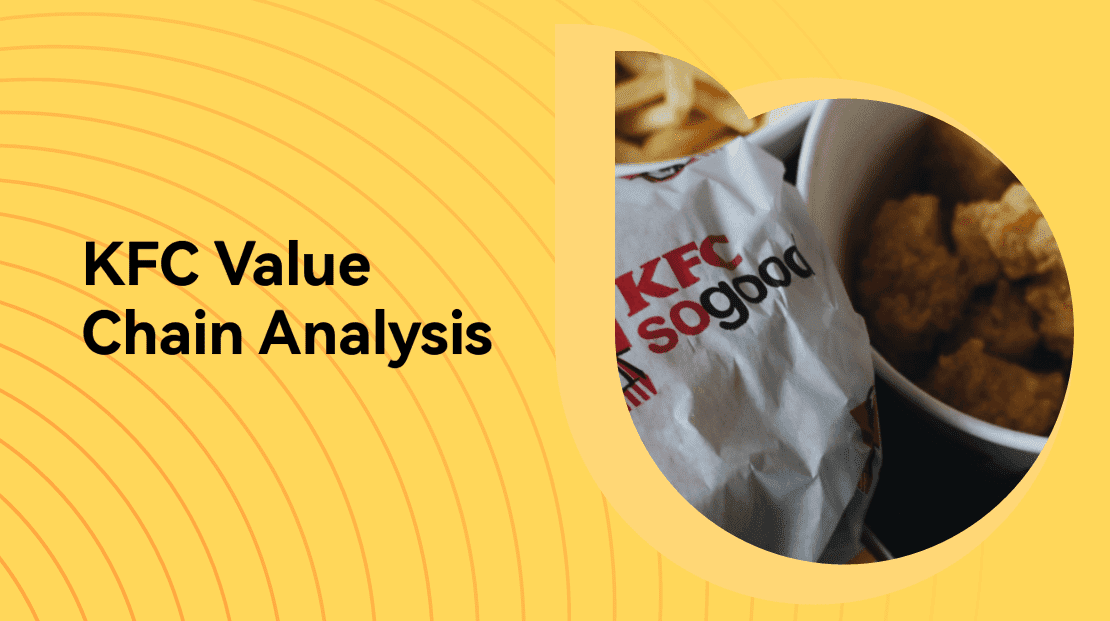In the highly competitive global fast food industry, the ability to appeal to consumers' diverse taste preferences and deliver unique experiences is paramount. Amidst such a challenging landscape, KFC (Kentucky Fried Chicken) has successfully carved out a distinctive niche for itself, largely owing to its well-orchestrated marketing mix strategy. The aim of this article is to delve deep into KFC's 4Ps - Product, Price, Place, and Promotion - and explore how these elements synergize to give KFC a competitive edge.
KFC Marketing Mix (4Ps) Analysis Mind Map
To begin with, let's conceptualize KFC's 4Ps strategy through a mind map. A visual representation not only aids in understanding but also adds an element of engagement, enhancing our comprehension of the brand's marketing mix.
The Product element in the mind map represents KFC's broad array of offerings that are uniquely branded with a distinct taste, namely its secret blend of 11 herbs and spices. Moving on, the Price component underlines KFC's strategy of offering value for money with pricing options tailored to cater to diverse customer segments. Next, the Place node outlines KFC's extensive geographical coverage spanning numerous countries and cities across the globe. Lastly, the Promotion facet denotes KFC's extensive promotional activities such as advertisement campaigns, sponsorships, and digital marketing initiatives aimed at creating brand awareness and increasing sales.
Product Strategy of KFC
Delving deeper into the first 'P' of the 4Ps, we encounter KFC's masterfully crafted product strategy. The core pillar of their product strategy is a unique offering that stands out in the crowded global fast food landscape. This offering comes in the form of their signature fried chicken, perfected by Colonel Harland Sanders himself, infused with a secret blend of 11 herbs and spices. This unique recipe has remained unchanged over the decades and has set KFC apart from its competitors, providing a strong identity to the brand.
A variety of fried chicken products are offered by KFC - this includes their Original Recipe Chicken, Hot & Spicy variant, Extra Crispy chicken, and the famous Chicken Popcorn. These products cater to a broad spectrum of taste preferences, from traditional to spicy to crispy. Complementing their signature fried chicken are a wide range of sides, including coleslaw, mashed potatoes with gravy, biscuits, corn on the cob, and a variety of drinks and desserts.
Another facet of KFC's product strategy is its menu customization based on geographic locations. Recognizing that taste preferences vary greatly across cultures and regions, KFC innovates its menu to include local flavors. For example, in India, they offer the 'Paneer Zinger' and 'Veg Rice Bowl', considering the high prevalence of vegetarianism in the country. Similarly, in Japan during Christmas season, KFC's Christmas meal bucket has become a cultural phenomenon.
Moreover, KFC has also shown adaptability in response to global health trends. Acknowledging the increasing preference for healthier food options, they have introduced grilled chicken and salads in their menu. In certain markets like UK, KFC even launched vegan alternatives to cater to a growing vegetarian and vegan customer base.
Furthermore, KFC uses clever product bundling techniques to create combinations that offer greater value to customers and also enhance the company’s profitability. Their famous 'bucket' meals include an assortment of their best-selling items, available in different sizes and are particularly popular for group consumption during social gatherings and festive occasions.
Finally, it's important to note that product quality forms an integral part of KFC’s product strategy. They ensure that food items are prepared under hygienic conditions, adhere to quality standards and deliver the delicious taste that they promise.
Price Strategy of KFC
KFC's pricing strategy plays a vital role in its overall marketing mix, directly affecting its profitability and market position. At its core, KFC strives to provide consumers with quality products at affordable prices. This is reflected in their strategy, where they balance between maintaining competitiveness in the market while ensuring a satisfactory level of profitability.
To achieve this, KFC follows a mix of pricing strategies. For starters, they implement a cost-based pricing model. In this model, they factor in the cost of ingredients, labor, overheads and other elements of the production process while setting their prices. This helps them maintain operational efficiency and safeguards their profit margins.
Secondly, KFC employs tiered pricing to cater to diverse customer segments. The tiered structure includes different pricing levels for its varied product offerings, from individual meals to family-size buckets. This ensures they cater to a wide range of consumers - from those who are cost-conscious and prefer individual servings to those who seek more premium or larger quantities of food.
Another vital component of KFC's price strategy is their 'value meals' and combo offers. These bundled products offer an assortment of items at a lower combined price compared to purchasing each item separately. For consumers, this translates into perceived savings and better value for money, making such offers quite popular.
In addition, KFC effectively uses psychological pricing techniques to attract customers. For instance, pricing items just below a round number (say, 4.99insteadof5) creates an impression of the product being cheaper than it actually is. This technique has been proven to positively impact consumers' buying decisions.
Finally, the brand employs competitive pricing where necessary, taking into consideration the prices set by competitors in the market. They continually monitor their competitors' pricing strategies and make necessary adjustments to ensure they remain competitive without compromising on the quality and value of their products.
Place Strategy of KFC
KFC's place strategy is a masterstroke in strategic planning and implementation, demonstrating how effectively reaching customers directly correlates with overall business success. The primary principle of their strategy is to ensure KFC's delectable offerings are accessible to customers across diverse geographies.
KFC boasts an expansive network of outlets spanning numerous countries across the globe, making it one of the largest quick-service restaurant (QSR) chains in the world. These outlets are strategically located in bustling city centers, commercial areas, malls, airports, and even smaller town centers, ensuring maximum footfall and convenience for customers. A notable feature of KFC outlets is their standardized branding and decor, which maintain consistency and reinforce brand identity regardless of location.
In many markets, KFC has established drive-through outlets recognizing the increasing trend of on-the-go consumption. Such outlets not only cater to customers who prefer quick service without the need to disembark from their vehicles but also align with the modern preference for minimal contact dining experiences.
A significant aspect of KFC's place strategy in recent years has been its strong focus on digitization and delivery services. Acknowledging the growth of e-commerce and online food delivery platforms, KFC has robustly expanded its digital presence. Customers can now order their favorite KFC meals through the brand's website or via popular third-party food delivery apps, enabling them to savor KFC's offerings from the comfort of their homes.
Additionally, KFC utilizes a well-structured supply chain management system to ensure smooth operations. From sourcing quality ingredients to delivering the final product to customers, every process is meticulously planned and executed. The supply chain is regularly monitored and optimized for efficiency, ensuring that every KFC outlet across the globe functions seamlessly and upholds the brand's promise of delivering fresh and delicious meals.
Promotional Strategy of KFC
The promotional strategy of KFC is a testament to its acumen in understanding market dynamics and consumer behavior. Being one of the most recognizable fast-food brands worldwide, KFC utilizes a wide range of promotional activities that help the brand maintain its popularity and visibility.
One of the central elements of KFC's promotional strategy is its advertising campaigns. The brand leverages a plethora of media platforms like television, print, online channels, billboards, and radio for their advertisements. These ads are typically creative, fun, and engaging, effectively communicating KFC's offerings and values. The face of KFC’s advertising is none other than its founder, Colonel Sanders, depicted as a symbol of the brand's tradition and commitment to quality.
Online and social media promotion is another key pillar of KFC's promotional activities. In today's digital age, the brand has a robust online presence on popular platforms like Facebook, Instagram, Twitter, and YouTube. KFC often posts engaging content including product teasers, special offers, contests, user-generated content and more. Such efforts not only increase brand engagement but also facilitate direct communication with customers.
In addition to this, KFC runs various sales promotion activities. This includes offering discounts, value meals, limited-time offers, festive specials and more. These promotions incentivize customers to try out KFC's products and stimulate repeat purchases.
Public relations also form an essential part of KFC's promotional strategy. The company participates in and sponsors events, charities and causes that resonate with their customers’ values. For instance, KFC runs an initiative called ‘Add Hope’ where they partner with world hunger organizations to provide meals for underprivileged children.
Lastly, the brand indulges in direct marketing via email and SMS campaigns. These personalized messages include information about new products, special offers, or discount coupons that entice customers to make purchases.
KFC Marketing Mix (4Ps) Analysis Cheat Sheet
To recapitulate our detailed analysis, here is a succinct cheat sheet that captures the essence of KFC's marketing mix strategy:
- Product: Unique taste and product innovation
- Price: Value for money with varied pricing options
- Place: Global presence with physical outlets and digital platforms
- Promotion: Integrated marketing communication approach
Key Takeaways
KFC's marketing mix strategy is a testament to the brand's deep understanding of its target audience and the fast food market dynamics. The strategy underscores the significance of each of the 4Ps and how they seamlessly blend to ensure KFC's consistent market presence.
For those who aspire to replicate such success in their businesses, we recommend using Boardmix's pre-built 4Ps of Marketing Template. The template provides a structured framework and essential tools that can guide you in crafting your unique marketing mix strategy. A comprehensive understanding of these components will enable you to create a robust marketing strategy that will deliver superior customer value and achieve sustainable business growth.
KFC's marketing mix offers valuable insights into how an effective combination of product, price, place, and promotion can contribute to building a strong brand and achieving market leadership. This analysis has demonstrated that success in the market isn't solely about having a good product but orchestrating the 4Ps in a way that resonates with the target audience.









